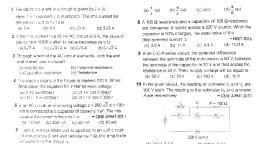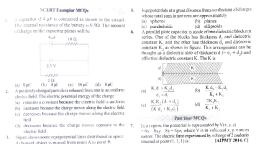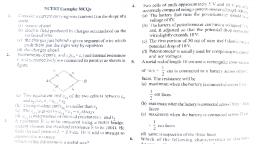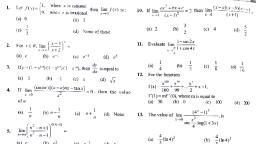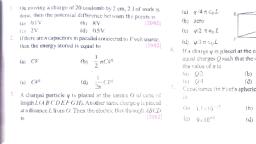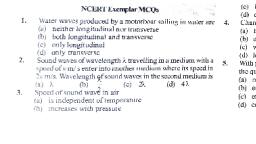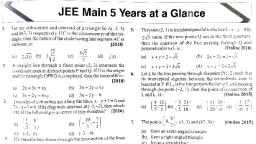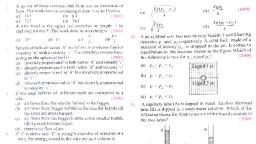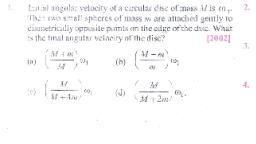Question 1 :
A block of mass 2 kg is placed on the floor. The coefficient of static friction is 0.4. If a force of 2.8 N is applied on the block parallel to floor, the force of friction between the block and floor (Taking <img style='object-fit:contain' src="https://storage.googleapis.com/teachmint/question_assets/NEET/5e91774e67ed907b153d28bb">) is
Question 3 :
A body of mass 2 kg is placed on a horizontal surface having kinetic friction 0.4 and static friction 0.5. If the horizontal force applied on the body is 2.5 N, the frictional force acting on the body will be ( g = 10 $ms^2$)
Question 4 :
A block of mass $5$ kg is lying on a rough horizontal surface. The coefficient of static and kinetic friction are $0.3$ and $0.1$ and $g=10ms^{-2}$. The frictional force on the block is?
Question 5 :
The arrow with a pointed tip can move faster in air than that of with a blunt tip.<br/>
Question 6 :
Consider the following two statements :</p> I. Linear momentum of a system of particles is zero. </p> II. Kinetic energy of a system of particles is zero. Then
Question 7 :
A ring takes time $t_1$ and $t_2$ for sliding down and rolling down an inclined plane of length $L$ respectively for reaching the bottom. The ratio of $t_1$ and $t_2$ is
Question 8 :
An ice cart of mass 60 kg rests on a horizontal snow patch with coefficient of static friction<img style='object-fit:contain' src="https://storage.googleapis.com/teachmint/question_assets/NEET/5e917ad81a95347cde4a11ef">. Assuming that there is no vertical acceleration, find the magnitude of the maximum horizontal force required to move the ice cart <img style='object-fit:contain' src="https://storage.googleapis.com/teachmint/question_assets/NEET/5e917b3b313cbb7c3feadf82">
Question 9 :
Two smooth cylindrical bars weighing {tex} W {/tex} each lie next to each other in contact. A similar third bar is placed over the two bars as shown in figure. Neglecting friction, the minimum horizontal force on each lower bar necessary to keep them together is<br><img style='object-fit:contain' src="https://storage.googleapis.com/teachmint/question_assets/NEET/5e101e274faa335027dc7b31">
Question 10 :
A cricket ball of mass 0.25 kg with speed 10 m/s collides with a bat and returns with same speed with in 0.01 s. The force acted on bat is
Question 12 :
A cold soft drink is kept on the balance. When the cap is open, then the weight
Question 13 :
A body of mass $2$ kg is slipping on a frictionless horizontal table with a velocity of $4$ m/s. The necessary force in newton to keep the body moving with the same velocity will be:
Question 14 :
Force of 4 N is applied on a body of mass 20 kg. The work done in 3rd second is
Question 15 :
A closed compartment containing gas is moving with some acceleration in horizontal direction. Neglect effect of gravity. Then the pressure in the compartment is
Question 16 :
A cylindrical vessel is filled with a liquid of density 'p' upto height 'h' and placed on a horizontal surface. Coefficient of friction between the vessel and surface is $\mu$. What should be the minimum area of a hole near the bottom of the vessel so that when the hole is unplugged, vessel begins to move? Mass of vessel and liquid is 'M' <br>
Question 17 :
The coefficient of static friction between contact surfaces of two bodies is $0.5$. The contact surfaces of one body support the other till the inclination is less than(Approximately).
Question 19 :
Assertion: In order to reduce sliding friction, lubricants are used.
Reason: Lubrication changes the conditions of rubbing, replacing the sliding friction by rolling friction, thereby reducing the force of friction.
Question 20 :
A player caught a cricket ball of mass 150 g moving at the rate of <img style='object-fit:contain' src="https://storage.googleapis.com/teachmint/question_assets/NEET/5e91780a313cbb7c3feadbe3">. If the catching process be completed in 0.1 s, the force of blow exerted by the ball on the hands of the player is
Question 21 :
You are marooned on a frictionless horizontal surface and cannot exert any horizontal force by pushing against the surface. How can you get off ?
Question 22 :
For which type of surface magnitude of frictional force would be less?<br>
Question 24 :
{tex}\mathrm{Statement \ I}{/tex} : A cloth covers a table. Some dishes are kept on it. The cloth can be pulled out without dislodging the dishes from the table.<br> {tex}\mathrm{Statement \ II}{/tex} : For every action there is an equal and opposite reaction.
Question 25 :
Choose the correct statements. The coefficient of static friction depends on<br/>(1) the material of the bodies in contact.<br/>(2) quality of machining of the surface in contact.<br/>(3) presence of foreign matter between the surface.<br/>(4) area of the surfaces in contact.
Question 26 :
The coefficient of friction between the tryes and the road is 0.25. the maximum speed with which a car can be driven round a curve of radius 40 m without skidding is (assume g= 10$ms^{-2}$)
Question 27 :
A book of weight $20$ $N$ is pressed between two hands and each hand exerts a force of $40$ $N$. If the book just starts to slide down, then the coefficient of friction is
Question 29 :
If the normal force is doubled, the co-efficient of friction is?
Question 30 :
A body is moving along a rough horizontal surface with an initial velocity of $10 {ms}^{-1}$. If the body comes to rest after travelling a distance of $12 m$, then the coefficient of sliding friction will be

